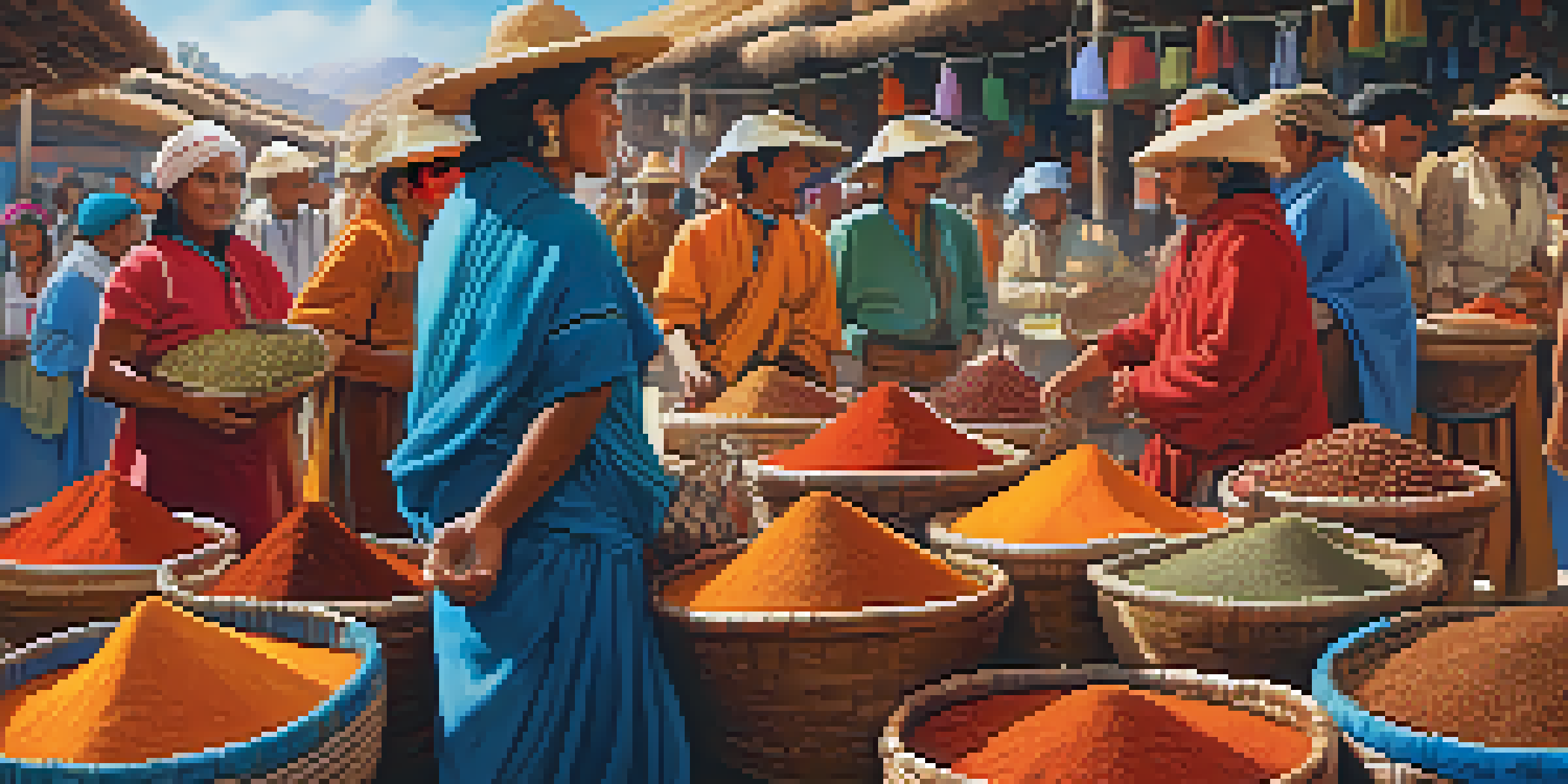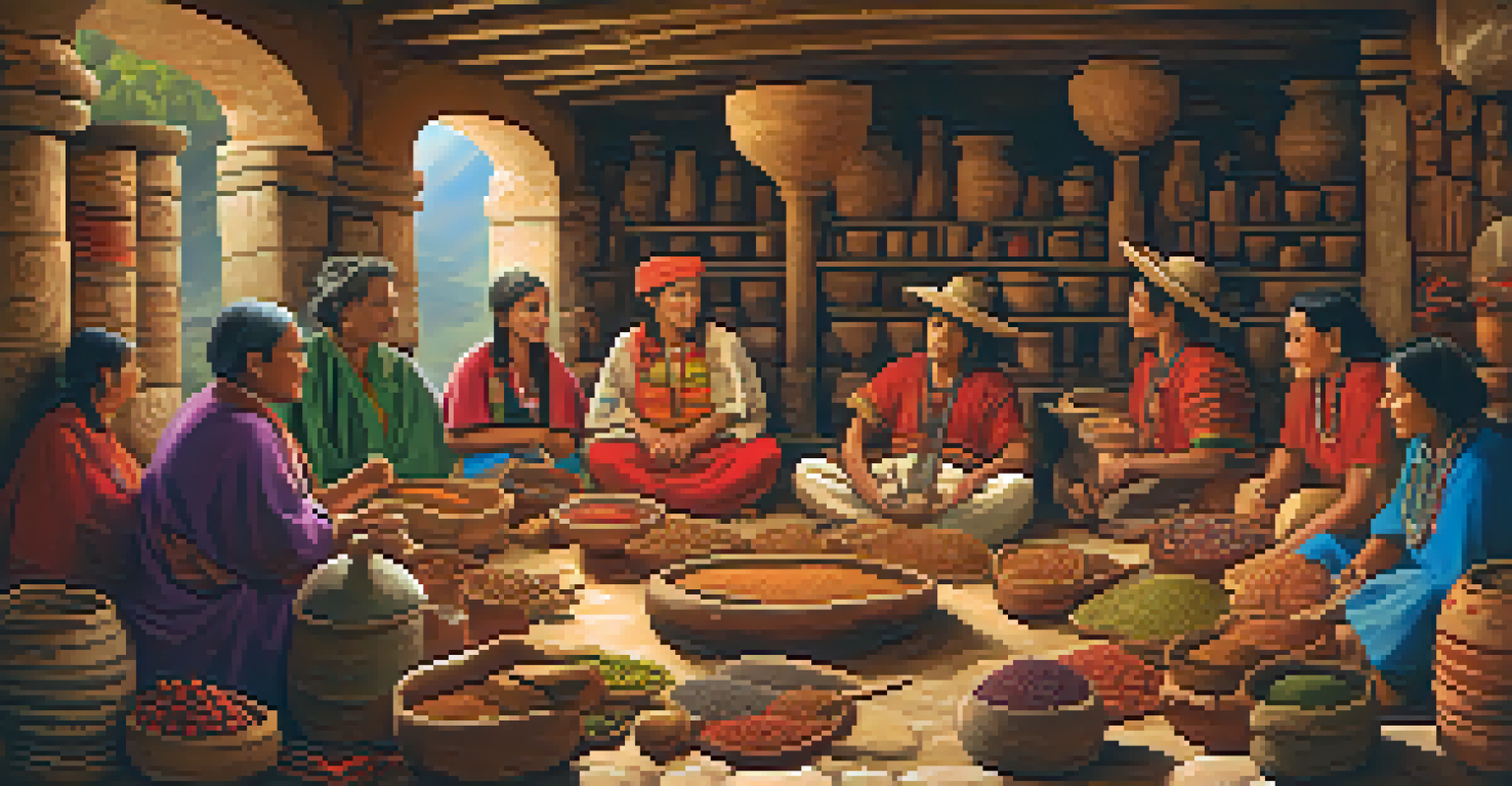The Impact of the Spice Trade on Ancient Peruvian Routes

Understanding the Spice Trade's Global Importance
The spice trade was a major driver of ancient economies, connecting diverse cultures. Spices like cinnamon, pepper, and saffron were highly sought after not just for flavor but for their medicinal properties. This demand created a bustling network of trade routes that spanned continents, influencing societies from the Middle East to Asia and beyond.
Spices are the most important trade good of the Middle Ages, and they were traded in great quantities. They were worth their weight in gold.
In ancient Peru, while the focus was often on local agricultural products, spices still held an allure. The Incas, for example, were known to engage in trade with neighboring regions, bringing in exotic goods. This exchange of spices and other items fostered a rich cultural tapestry that shaped Peruvian society.
The allure of spices also triggered exploration and expansion of territories. Traders sought new routes and connections, which ultimately led to increased interactions between civilizations. This dynamic not only enriched local economies but also encouraged the spread of ideas, technologies, and cultural practices.
Ancient Peruvian Routes and Their Development
Before the arrival of the Spanish, ancient Peru was home to sophisticated trade networks. The Incas established an extensive road system known as the Inca Trail, which facilitated the movement of goods, including spices. This connectivity allowed for not just the transport of products but also the exchange of cultural practices and innovations.

These routes were not just physical pathways; they represented the lifeblood of commerce and communication. They linked various communities, from coastal towns to highland villages, creating a sense of unity among diverse populations. This integration was crucial for the distribution of both local and foreign goods.
Spice Trade Shaped Ancient Economies
The spice trade fostered economic growth in ancient Peru by creating specialized markets and enhancing local commerce.
As the spice trade flourished, it provided an incentive for further exploration and the establishment of more trade routes. The increased demand for spices led to improved infrastructure and the development of marketplaces where these goods could be traded. This evolution played a vital role in the economic growth of ancient Peru.
Influence of the Spice Trade on Local Economies
The spice trade had a significant impact on local economies in ancient Peru. As spices became coveted items, communities began to specialize in their production and trade. This specialization allowed for the emergence of new economic hubs, transforming local economies into thriving centers of commerce.
The spice trade was not just about commerce; it was a catalyst for cultural exchange and the sharing of ideas that shaped civilizations.
In addition to spices, the trade routes allowed for the exchange of other goods, such as textiles and ceramics. This diversified the economy and encouraged innovation, as artisans and farmers sought to improve their products to meet the growing demand. The exchange also fostered competition, which often led to higher quality goods.
Moreover, the influx of wealth from spice trading brought about social changes. Communities that engaged in spice trade often experienced a rise in status and influence. This newfound prosperity allowed for advancements in technology and infrastructure, further enriching the culture and lifestyle of the people.
Cultural Exchange Through Spice Trade Routes
Trade routes were not only conduits for goods but also for cultural exchange. As traders moved through ancient Peru, they brought with them new ideas, languages, and customs. This exchange enriched the local culture, leading to a fusion of traditions that shaped the identity of the region.
For instance, the introduction of spices influenced local cuisine significantly. New flavors and cooking techniques emerged, creating a unique culinary landscape that reflected both local and foreign influences. This culinary exchange is still evident in modern Peruvian cuisine, which is celebrated for its diversity and richness.
Cultural Exchange Enriched Societies
Trade routes facilitated the exchange of ideas, customs, and culinary practices, blending local traditions with foreign influences.
Additionally, the spice trade facilitated the spread of religious and philosophical ideas. As traders interacted, they shared beliefs and practices, leading to a broader understanding of different cultures. This exchange laid the groundwork for a more interconnected world, which was especially significant in ancient times.
The Role of the Inca Empire in Spice Distribution
The Inca Empire played a central role in the distribution of spices throughout ancient Peru. Their vast empire stretched across diverse environments, allowing them to access a variety of agricultural products. The Incas leveraged this advantage to control the spice trade and ensure a steady supply to their populace.
By establishing a robust administrative system, the Incas were able to regulate trade and manage resources effectively. They implemented a system of tribute, where conquered communities would provide goods, including spices, to the empire. This practice not only secured a steady flow of spices but also reinforced the Inca's power and influence.
Moreover, the Incas' focus on agricultural innovation contributed to the spice trade. They developed advanced farming techniques, such as terracing, which increased the productivity of spice crops. This agricultural prowess ensured that they could meet both local and external demands for spices, solidifying their economic strength.
Challenges Faced in the Spice Trade
Despite its many benefits, the spice trade was fraught with challenges. Geographic barriers, such as mountains and rivers, made the transport of goods difficult. Traders often faced perilous journeys, and the risk of losing valuable cargo was ever-present, which could deter participation in the trade.
Additionally, the demand for spices led to fierce competition between traders and empires. Conflicts could arise over control of trade routes or specific spice-producing regions. These rivalries not only impacted the traders but also affected local communities caught in the crossfire.
Incas Enhanced Spice Distribution
The Inca Empire effectively regulated and expanded the spice trade through advanced agricultural techniques and a robust administrative system.
Moreover, changing climates and environmental factors could disrupt spice production. Droughts or floods could severely impact crop yields, leading to shortages and inflated prices. These challenges necessitated adaptability and resilience among traders and producers to maintain their livelihoods.
Legacy of the Spice Trade in Modern Peru
The legacy of the spice trade continues to resonate in modern Peru. The historical routes established by ancient traders paved the way for contemporary trade networks, facilitating both local and international commerce. This historical significance is often celebrated in Peruvian culture.
Moreover, the influence of spices on Peruvian cuisine has become a point of national pride. Modern chefs frequently draw inspiration from traditional recipes that incorporate spices, blending them with contemporary techniques to create innovative dishes. This culinary evolution reflects the enduring impact of the spice trade.

Finally, the story of the spice trade serves as a reminder of the importance of cultural exchange. It highlights how interconnected our world has always been, even in ancient times. By understanding this legacy, we can appreciate the rich tapestry of history that shapes modern Peru and its vibrant culture.